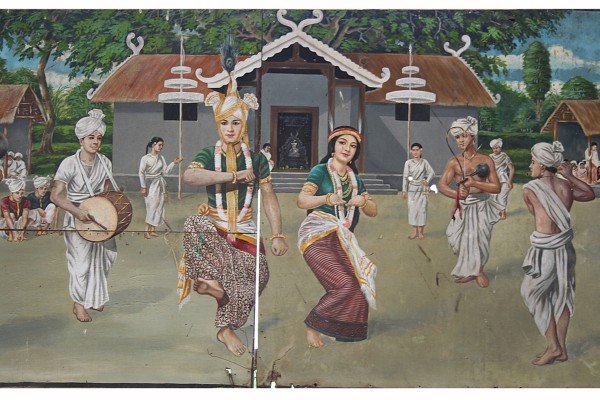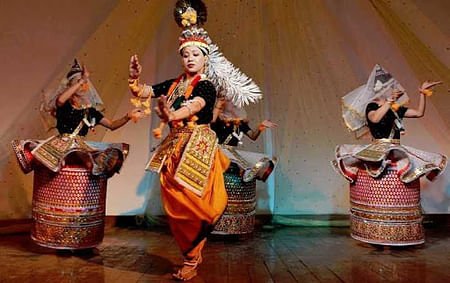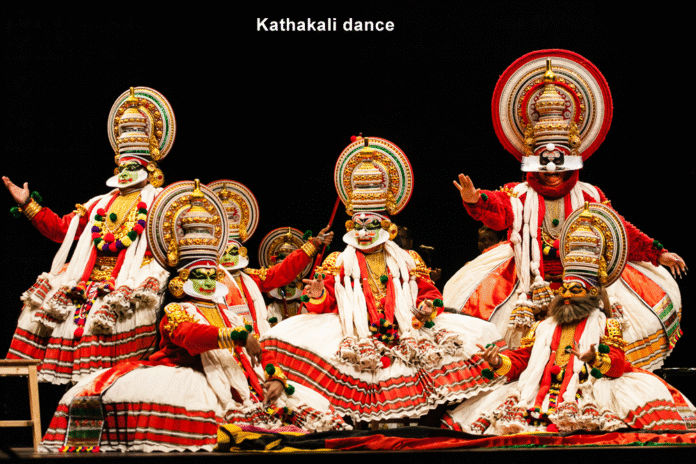When the delicate hand gestures of Ras Lila swirl with the flowing costumes of Manipur dance, you don’t just watch a performance — you witness poetry in motion. But now, this centuries-old dance form is leaping off the stage and landing gracefully onto canvases, sculptures, textile prints, and digital art.
This is the story of how Manipur dance tradition is inspiring a bold new wave of visual expression, keeping the heritage alive while shaping the future of Indian art.

📜 1. Understanding the Roots: The Soul of Manipur Dance
Originating from the north-eastern state of Manipur, this classical dance is more than just movement — it’s a spiritual expression. Closely tied to Vaishnavism (the worship of Lord Krishna), the dance form is traditionally performed during festivals, temple rituals, and especially during Rasa Lila — the enactment of the love story of Krishna and Radha.
Key characteristics include:
- Gentle, flowing body movements
- Expressive facial expressions
- Emphasis on Lasya (graceful, feminine movement)
- Intricately embroidered costumes
- Strong musical accompaniment with Pung (drum) and kartals
Unlike the dramatic nature of Kathakali or Bharatanatyam’s sharp expressions, Manipuri dance is soft, internalized, and devotional.
🎨 2. Visual Art Embracing the Language of Movement

In recent years, contemporary visual artists have begun incorporating dance aesthetics into their paintings, illustrations, and mixed media pieces.
Why?
Because dance — especially Manipuri — offers a visual rhythm, a flowing narrative that can be translated into brushstrokes, fabric folds, and even abstract geometric patterns.
Common visual interpretations include:
- Silhouettes of Ras Lila dancers in motion
- Textile prints mimicking the radial symmetry of Manipuri skirts
- Ink sketches capturing mudras (hand gestures)
- Wall murals portraying Krishna-Radha love scenes in motion
These works capture not just the form but the emotional essence of the dance — devotion, love, joy, longing.
🖌️ 3. Manipuri Dance Motifs in Textile and Fabric Design

One of the strongest areas where dance meets design is in fashion and fabric art.
Designers are borrowing elements such as:
- Phanek: The traditional sarong worn by women
- Potloi: The stiff embroidered costume of Ras dancers
- Bright, circular patterns representing the flowing movements
Fashion houses and handloom artists are using dance silhouettes in hand block printing, embroidery work, and woven motifs, creating wearable art inspired by traditional dance.
🖼️ 4. Canvas as Stage — Painters Who Dance With Brushes
Modern Indian painters like Jamini Roy and K.K. Hebbar have long captured the spiritual essence of dance in their works. But now, emerging Manipuri artists and illustrators are spotlighting their own cultural dance as central themes.
Notable themes:
- Abstract art showing movement trails
- Traditional paintings that freeze a dance pose mid-movement
- Portraits of Manipuri dancers in festival attire
- Digital artworks merging traditional costumes with modern color palettes
This fusion creates an engaging dialogue between heritage and contemporary expression.
🛕 5. Temples and Walls: Sacred Dance in Sacred Spaces
Temple murals in Manipur — especially in Govindajee Temple, Imphal — show Lord Krishna dancing with the Gopis, influenced by the Ras Lila tradition. These visual stories on walls serve both religious and artistic purposes.
Modern murals and street art are now reimagining these scenes for a wider, secular audience — painted on school walls, metro stations, and public spaces in Manipur and beyond.
The message is clear: Cultural identity deserves a public canvas.
🧑🎓 6. Art Schools in Manipur Fostering the Fusion
Institutes like:
- Jawaharlal Nehru Manipur Dance Academy
- Imphal Art College
- Manipur University’s Art & Culture Department
…are promoting cross-disciplinary learning. Students explore how classical dance can influence:
- Composition and rhythm in painting
- Gesture in sculpture
- Textile design and costume craft
- 3D installations and performance art
This academic encouragement is cultivating a new generation of hybrid artists — equally comfortable with both choreography and color palettes.
🔍 7. Digital Art & Animation: Preserving Movement Forever
Manipuri artists are also stepping into digital storytelling and animation. Platforms like Instagram and Behance now showcase:
- GIFs of animated dancers
- Time-lapse videos of paintings made to traditional music
- Interactive digital installations that move when you move
Technology becomes a tool to preserve dance movements that are otherwise fleeting.
One exciting initiative includes a VR-based Ras Lila performance designed to immerse viewers in the art, sound, and soul of Manipuri tradition.
💡 8. Why This Fusion Matters Today
In a world increasingly digital and disconnected from roots, blending dance with design ensures that cultural traditions remain relevant and visible.
The benefits:
- Inspires young artists to explore tradition
- Promotes regional identity in a global world
- Connects art disciplines, creating more holistic artists
- Brings Manipuri culture into mainstream national dialogue
This fusion is more than aesthetic — it’s cultural preservation through evolution.
🔗 Related Blogs You Might Like
- Kutch’s Rogan Art: The 400-Year-Old Cloth Painting Tradition
- Pattachitra from Odisha: Tales of Gods on Palm Leaves
- Kerala’s Mural Paintings: Mythology on Walls
- For More Detail Go to this Wikipedia Link
🧾 Conclusion: A Living Tradition in Motion and Color
From a swirling ghungroo to the stroke of a brush — Manipur’s classical dance is not limited to performance spaces anymore. It is flowing freely across disciplines, becoming a muse for painters, designers, illustrators, and textile artists.
As dance becomes design, and motion becomes memory, a new language of art is forming — one that speaks of tradition without speaking a word.
This isn’t just a trend — it’s a cultural revolution, painted one canvas at a time.
